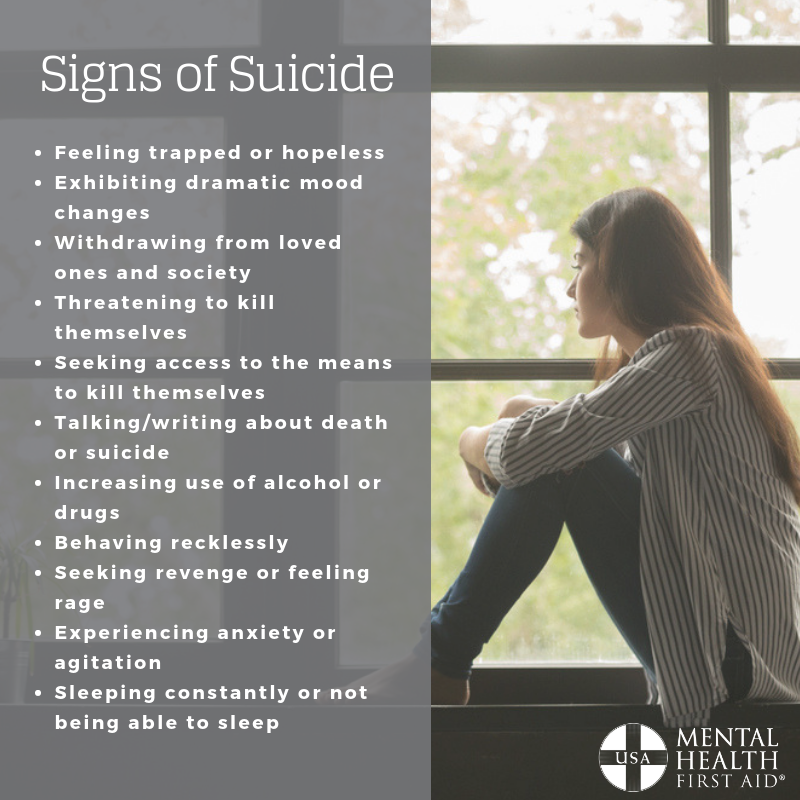If you or someone you know is considering suicide, call 9-1-1 or the National Suicide Prevention Lifeline at 1-800-273-TALK (8255).
On average, there are 129 suicides every day, and for every suicide 25 more people attempt suicide.
The numbers are staggering, but there are ways we can help.
It can be intimidating to talk about suicide or ask people about what they’re going through, but this guide will explain how to help someone who is suicidal.
Sometimes people will exhibit multiple signs, but others won’t exhibit any.
But to start, it’s helpful to look for the signs of suicide:

If you suspect someone you know is considering suicide, Mental Health First Aid teaches you to follow the ALGEE action steps.
1. ASSESS for risk of suicide or harm: The best way to find out if someone is considering suicide and determining the urgency of the situation is to ask them:
Are you having thoughts of suicide?
Do you have a plan to kill yourself?
Have you decided when you’d do it?
Do you have everything you need to carry out your plan?
IMPORTANT NOTE: Some people believe that mentioning suicide might cause someone to consider suicide for the first time. This is not true, so do not be afraid of this outcome. You’re much more likely to help someone feel less alone if they were considering it.
If they have a plan and are ready to carry out that plan, call 911 immediately. How you respond to other answers will depend on the situation, but always call 911 if you’re unsure. It’s better to be safe that for someone to lose their life.
Additionally, not having a plan doesn’t mean they’re not in danger. All thoughts of suicide must be treated seriously.
If you think the person is in danger, you need to keep the person safe. Stay with them for as long as you can, because an actively suicidal person shouldn’t be left alone. If you can’t stay, find someone who can until help arrives.
If you determine the person is having suicidal thoughts but there’s no immediate danger, engage in conversation with them if possible.
2. LISTEN nonjudgmentally: If the person does not appear to be in a crisis, encourage them to talk about what they’re thinking and how they’re feeling. It can be hard to hear someone you know is experiencing distress, but when you listen and genuinely care, you can have a calming, positive impact on them, and you can start to learn more about what is at the root of their suicidal thinking.
You may not fully understand what they’re going through, and that’s OK. What’s important is that you’re accepting of what they’re saying, acknowledge it and genuinely try to imagine what it might be like for them. Staying patient and respectful can make a world of difference.
If, while you’re listening, you discover they may in fact be in crisis, return to the ASSESS step in No. 1.
3. GIVE reassurance and information: Reassurance is crucial, as people having suicidal ideation may not have much hope. Clearly state to them that suicidal thoughts are often associated with a treatable mental illness, and if you feel comfortable, you can also offer to help them get the appropriate treatment. You can also tell them that thoughts of suicide are common, and that you don’t have to act on them.
4. ENCOURAGE appropriate professional help: If you are concerned for the person’s immediate safety, call 911.
If you’re concerned but it’s not an immediately urgent situation, make sure the person has a safety contact available at all times, whether it’s a loved one or mental health professional. Another great resource is the National Suicide Prevention Hotline: 1-800-273-TALK.
If the crisis has passed, or the person wasn’t actively suicidal but has suicidal thoughts, encourage the appropriate psychological or medical help. If you want to provide further assistance, offer to call medical professionals if they don’t already have one to schedule an appointment, or do any of the other legwork required to get them help. Remind them that recovery is possible with treatment.
5. ENCOURAGE self-help and other support strategies: Ask the person to think about what has helped them in the past. Perhaps a particular therapist, family member, friend or spiritual leader has given them support, or maybe a particular community, like a church or club, has been there for them. They should tap into their support system as much as possible during this time.
REMEMBER: These steps don’t have to necessarily go in order. Apply them in whichever way makes sense for you and the person you’re addressing.
To learn more support strategies, take Mental Health First Aid. The course will teach you how to identify, understand and respond to signs of mental health or substance use issues.
Remember: Always remember to practice self-care after a crisis situation. These types of encounters won’t be easy for you, but your confidence and support can make a huge difference in someone’s life.